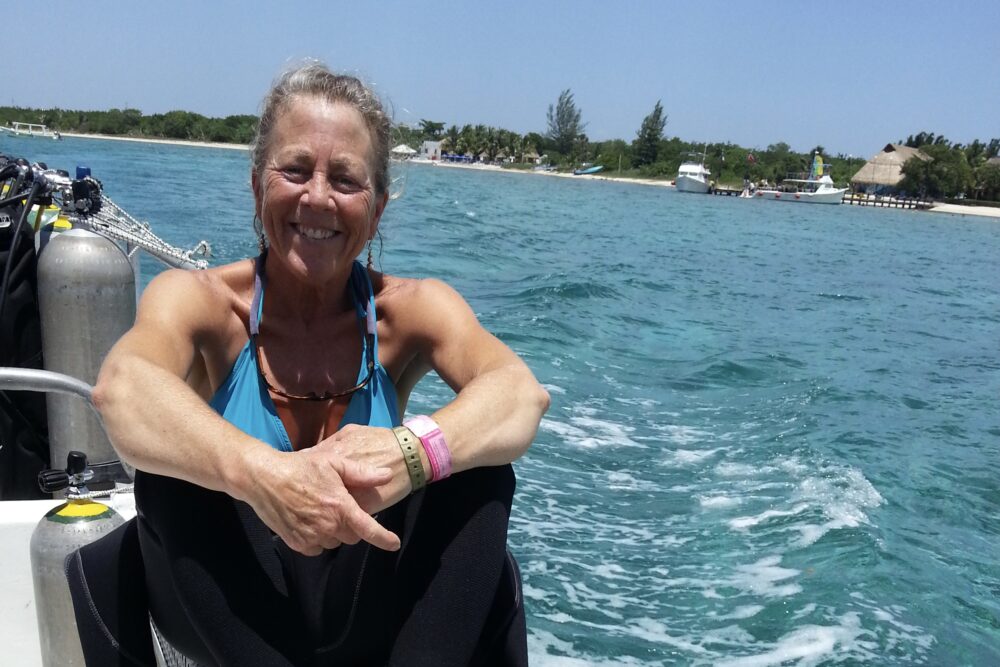Scuba Diving in the Caribbean and Bahamas: Insider’s Guide
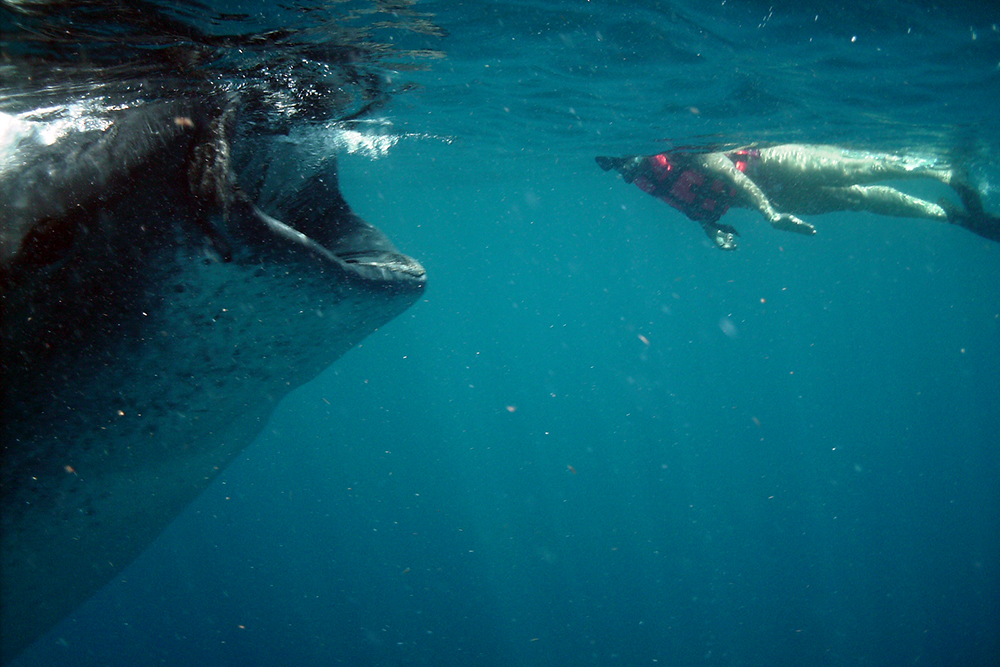 Gulp: snorkeling near a whale shark off Isla Contoy, Mexico. Photo: Meg Austin.
Gulp: snorkeling near a whale shark off Isla Contoy, Mexico. Photo: Meg Austin.
The insider advice on this page is from one of Wendy’s Trusted Travel Experts for the Caribbean and the Bahamas, Meg Austin.
Meg’s longstanding friendships on select Caribbean islands that offer spectacular resorts—specifically, Anguilla, Antigua, the Cayman Islands, Dominica, Nevis, St. Barts, St. Kitts, St. Lucia, and Turks and Caicos—as well as on Mexico’s Riviera Maya (on the Caribbean Sea) translate to special treatment for her travelers. That could mean a coveted snorkeling time before the cruise-ship day-trippers arrive, or the last room at a nearly sold-out hotel. An avid diver and snorkeler, she is your best resource for vacations that you hope to spend in large part underwater. She’s also a fount of ideas for keeping everyone in your multigenerational family happy (especially any who want to get scuba-certified).
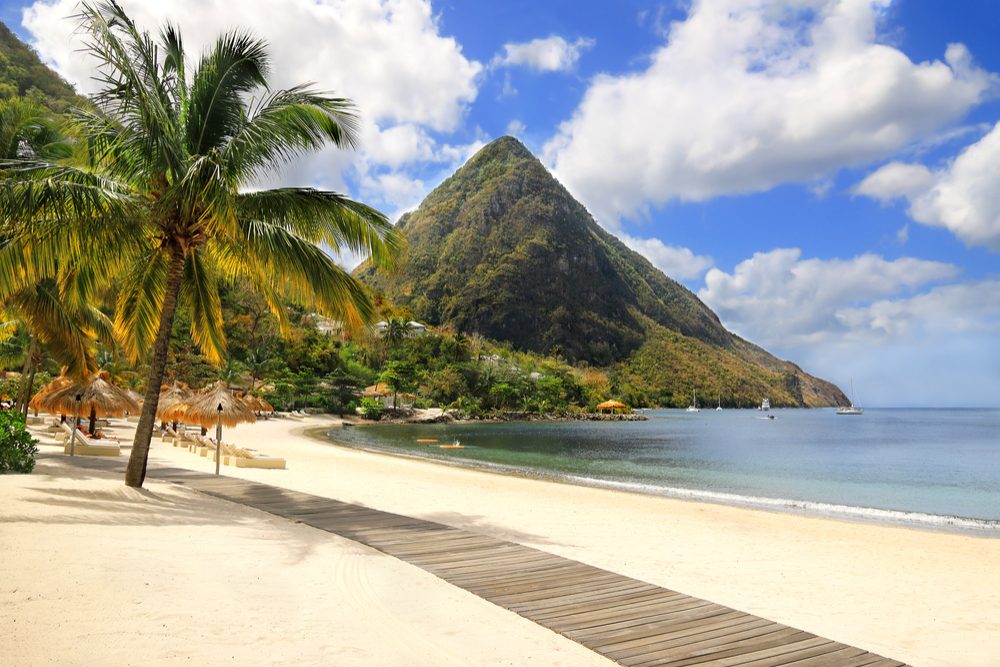
St. Lucia’s volcanic pitons make for excellent diving opportunities. Photo: Shutterstock
Where to Stay
Best-bang-for-your-buck hotels
The Viceroy Sugar Beach and Jade Mountain, two of St. Lucia’s most luxurious hotels—which also happen to be perfectly located for superb diving—drop their rates in the fall. They’re not inexpensive but worth every penny, and with great added value. The same goes for the more low-key Anse Chastenet, Jade Mountain’s sister property. All three are close to the Pitons, the island’s famous twin volcano plugs that don’t just jut up, they jut down too, making for excellent wall dives and shore dives. One of Meg’s favorite spots there is the Fairyland dive, where you’ll see little shrimp and arrow crabs that sparkle gold and blue. For a romantic splurge, book one of Jade Mountain’s hilltop rooms; with only three walls, they offer jaw-dropping views, and many have private pools.
Best luxury dive resorts
For the ultra dive experience as well as ultra luxury, check out Amanyara in Turks and Caicos and Cayo Espanto in Belize. They’re both to-die-for resorts, with excellent dive teams and stellar dive sites. Cayo Espanto, which is a stone’s throw from the second-largest reef in the world, offers all-inclusive dive packages.
Best liveaboard
The Aqua Cat catamaran in the Bahamas does a fabulous job and has wonderful accommodations. Or rent your own crewed yacht with a dive master who will make sure the experience is exactly what you want it to be (see “Bragging Rights”).
Where to Dive
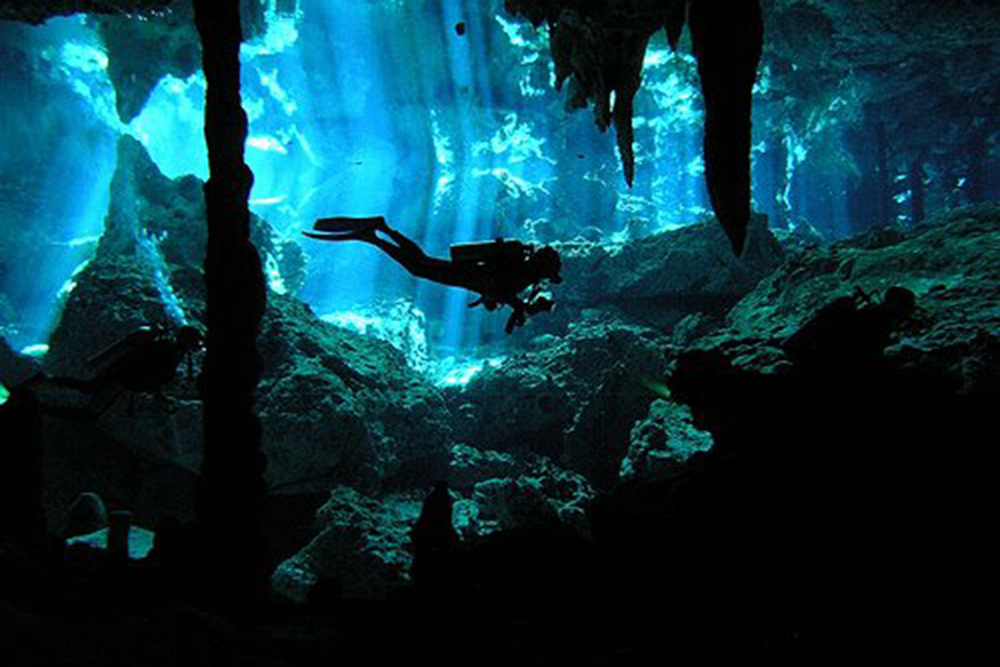
Dive inside a cenote in Mexico’s Riviera Maya.
Dives you have to try
Cenote diving. Natural pools formed in underground caverns, cenotes are found all over Mexico’s Yucatan Peninsula, with the largest concentration in the Riviera Maya. Some people worry that they’ll be claustrophobic, but the water is so clear you feel like you’re suspended in outer space—or in heaven, with all the sunlight filtering in from above. Meg’s favorite cenote is called Taj Mahal after a doppelganger stalagmite. Even if the weather isn’t great on land, the weather doesn’t change in the cave—cenotes are perfect year-round! You can even pair your cenote dive with a side trip to snorkel with the whale sharks in August, when these amazing creatures visit the Riviera Maya in the greatest numbers.
Macro diving is all about looking for tiny sea creatures that underwater photographers love to capture with their macro lenses—critters like sea horses, frogfish, and octopi. Dominica has some wonderful macro dive spots. And while you’re there, be sure to stop by Waitukubuli’s Authentic Kitchen for lunch!
Most overrated dive destinations
Meg has a love-hate relationship with Cozumel and Grand Cayman. Both can be overrun with passengers from all the large cruise ships that call on them. But Meg knows work-arounds—diving during off-peak times, for instance, and/or hiring a dive operator who knows the secret spots. What’s more, you can see bioluminescence around Grand Cayman, and the island has a wide variety of accommodations and above-sea-level activities.
Best for thrill-seekers
Shark diving. With its shallow reefs and abundant sunshine, the Bahamas are home to all kinds of sharks that, unlike whale sharks, are usually out and about year-round. Meg likes to do her shark diving in July and August; it’s the rainy season, but the water is the warmest.
Best places for new divers
St. Lucia’s Anse Chastenet has top-notch instructors and dive masters who can cater to both novice and experienced divers.
Children as young as 10 can be introduced to the sport as junior divers, but there are key elements to successfully and safely introducing children to diving. In the Riviera Maya, you can find a diversity of activity both above and below sea level, and the right dive team for young new divers and/or referral-course divers. More advanced divers in the group can ferry over to Cozumel for a day.
Best for shore diving
Bonaire. It’s a no-brainer—there are at least 100 easily accessible sites just off shore.
Best wreck diving
Meg’s favorite wreck is the Bianca C, in Grenada. It’s known as the Titanic of the Caribbean.
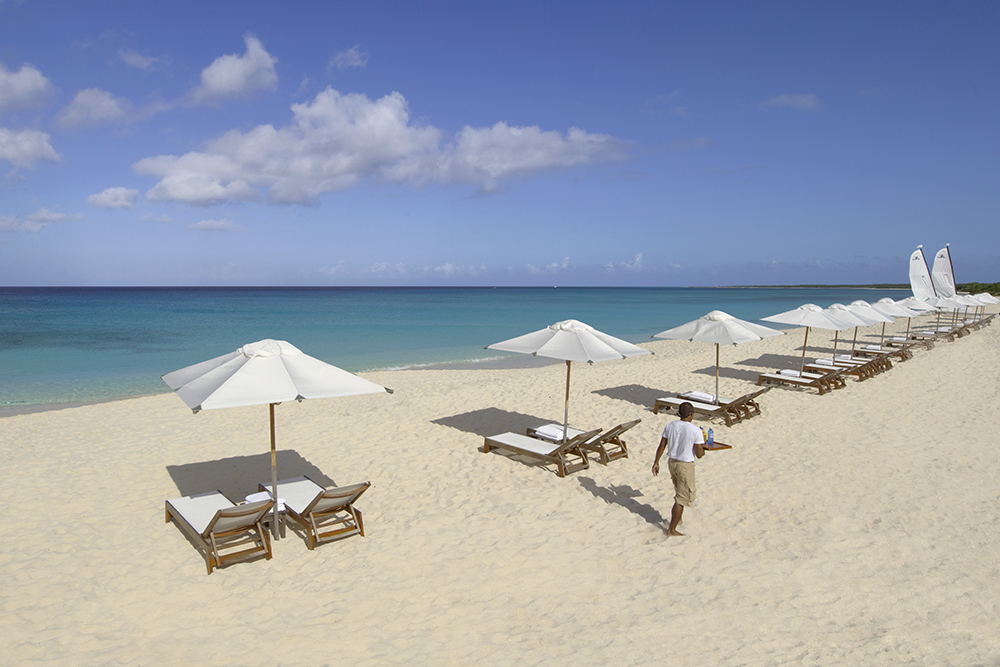
The beaches on Turks and Caicos are famously bright. Photo: Amanyara
Best reef diving
Meg says she could spend a year diving daily in Turks and Caicos—with its 7,000-plus-foot channels, canyons, walls, nooks, and crannies—and never get bored.
Cheap thrill
During slow periods (namely, mid-June through September or October) several dive resorts allow unlimited shore diving. Southern Cross Club in Little Cayman is one example.
Best nonresort dive masters
Turnover can be so fast in this business that it’s tough to recommend the same dive operator year after year, but in general, you’ll find the best instructors and guides at the dive shops that have been in business for a long time (and with the same owner). Dive Provo in Turks and Caicos is a consistent favorite of Meg’s. Amos, who owns and operates Big Animal Expeditions, offers small-group, once-in-a-lifetime experiences in the Caribbean; his sperm whale dive in Dominica is over the top! UnderWater Expeditions organizes private and small-group guided dives in Mexico’s Riviera Maya, including the cenotes.
Best Times to Go
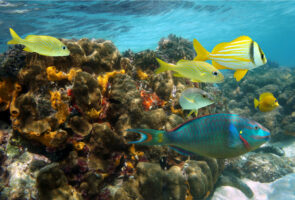
The period between Thanksgiving and Christmas is an excellent time to be in the Caribbean. You’ll find great prices, calm seas, and staff sporting big smiles (they’re just emerging from the quiet hurricane season and gearing up for the festive holiday season). Just after the holiday season and before Presidents’ Day week is another good time to get a deal, though it’s still the high season. During both periods, resorts tend to offer promotions, from free night stays to discounted dive packages.
February and March is especially good for Turks and Caicos, since that’s when you’re most likely to see humpback whales. These are otherwise quite rare in the Caribbean, but just off Grand Turk there’s a kind of whale highway where the ocean plunges 7,000 feet—you can see and hear the humpbacks as they pass through this trench on their annual migration. (Turks and Caicos is also a good choice in summer, since these islands are considered to be out of the hurricane belt, but the whales are long gone by then.)
August, September, and October fall during hurricane season but are Meg’s favorite time of year to be in the Caribbean. Storms are rare, the water is usually calm, the visibility generally excellent, and deals abound! Travel insurance is a must, just in case.
Best Times of Day to Dive
Avoid the peak dive times, when most of the big dive boats go out. That means starting your dives at 7 a.m. and 4 p.m. (instead of the more common 8 a.m. and 3 p.m. start times).
Predawn and night dives offer the chance to see some incredible nocturnal, bioluminescent sea creatures. There are dive spots in Puerto Rico, in particular, where you’ll be surrounded by glow-in-the-dark critters that light up the sea. (The best time to see those are under a new moon). Be careful about booking night dives with any old operator—some boats will pack in way too many people or will “park” in an already full locale. The last thing you want is to be in an overcrowded dive spot at night, when it’s easy to follow the wrong leader and end up in the wrong boat!
Biggest Rookie Mistakes
Not getting dive-certified before you arrive at the resort. PADI’s open-water referral course allows you to do the book and pool work thoroughly and comfortably at your own pace, close to home. Once you get to your resort, you can focus on your ocean dives to complete your certification.
Paying full price for the dives. Always ask about packages and see if other family members or dive buddies can be included: The more dives you commit to, the less you pay per dive.
Relying only on your medical or travel insurance to cover you if anything goes wrong. Diving is considered an “extreme sport” on most insurance policies and rarely covered by standard plans. Meg recommends Divers Alert Network’s annual membership, which includes emergency evacuations for diving and nondiving accidents.
Inside Scoop
Deeper is not always better. Shallow dives (about 30 to 40 feet) have more sunlight, the colors are brighter, and you can stay down longer. Relax and enjoy.
Airport Intel
Roatan has excellent diving and is now easier to get to, with nonstop flights from Atlanta and Denver. The Kimpton Grand Roatan, which opened in 2023 and is located in the West Bay, is the place to stay.
Dominica also has new nonstop service from Miami, and whales hang out here year-round.
South Caicos, a great adventure destination for both diving and fishing, is now accessible via a nonstop flight from Miami too.
Tipping Tip
It is customary to tip your dive-boat team. The suggested minimum is $20 per diver per two tank.
Don’t Forget to Pack
Alcohol-based ear drops help keep your ears dry and bacteria-free, and topical Benadryl for any allergic reaction (bug bites, sun poisoning, some reactions to fire coral).
Best Underwater Photo-Op
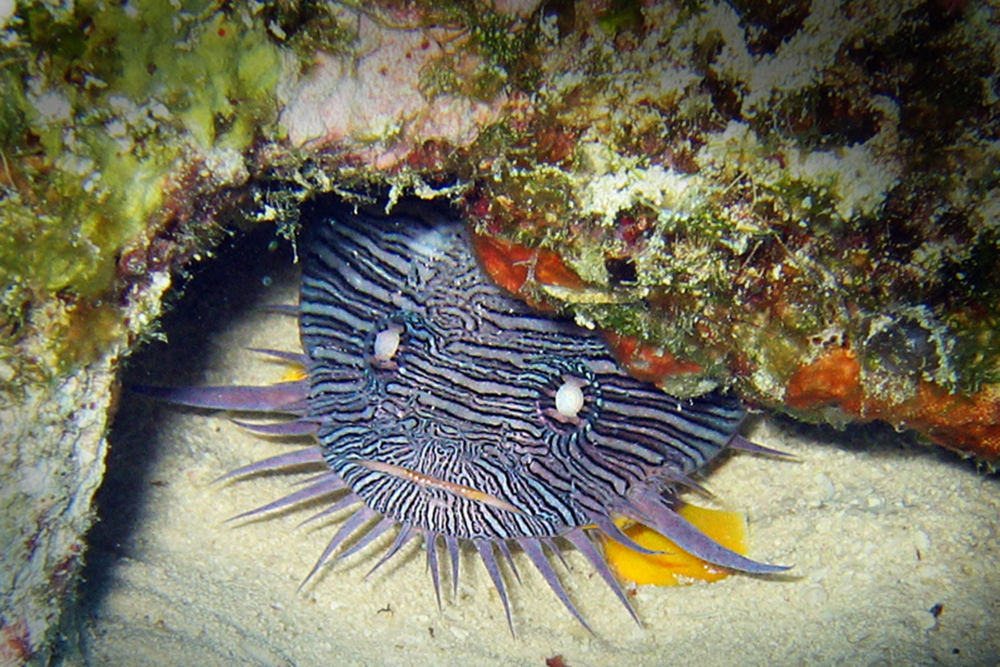
Capturing the elusive splendid toadfish. Found only near Cozumel, it’s extremely hard to spot—despite its bright yellow trim and distinctive black, blue, and white stripes—but a good dive master should be able to find the very shy toadfish hiding under ledges.
Bragging Rights
Charter your own vessel (anything from a standard dive boat to a fully crewed yacht), where you call the shots: You can request a dawn dive and watch the sea wake up! You will have the ocean to yourself and the chance to see those nocturnal fish without the crowds. The British Virgin Islands have the widest variety of boat charters and are the most reasonably priced. What’s more, with all those islands around, you’ll have plenty of dive sites to choose from.

